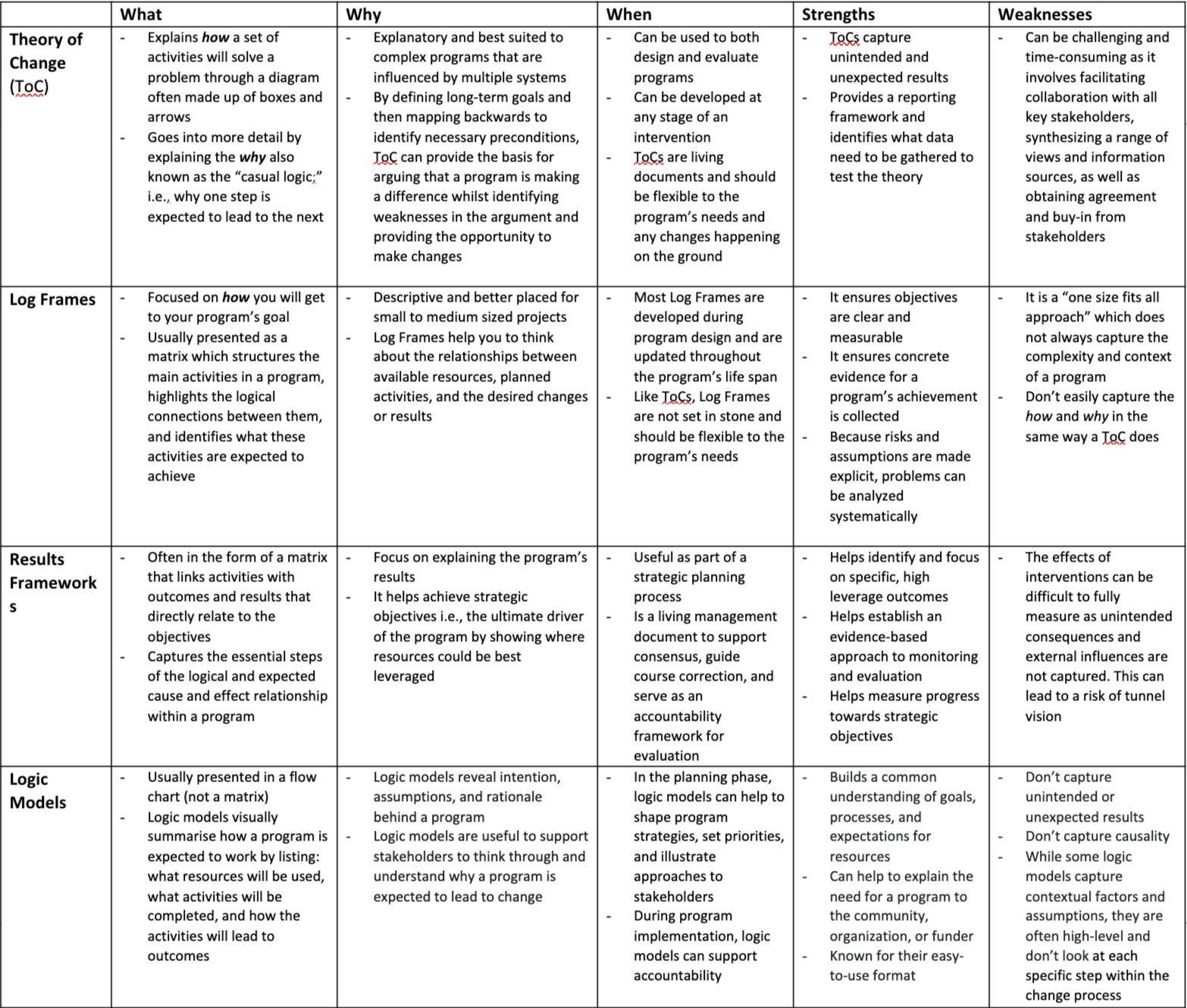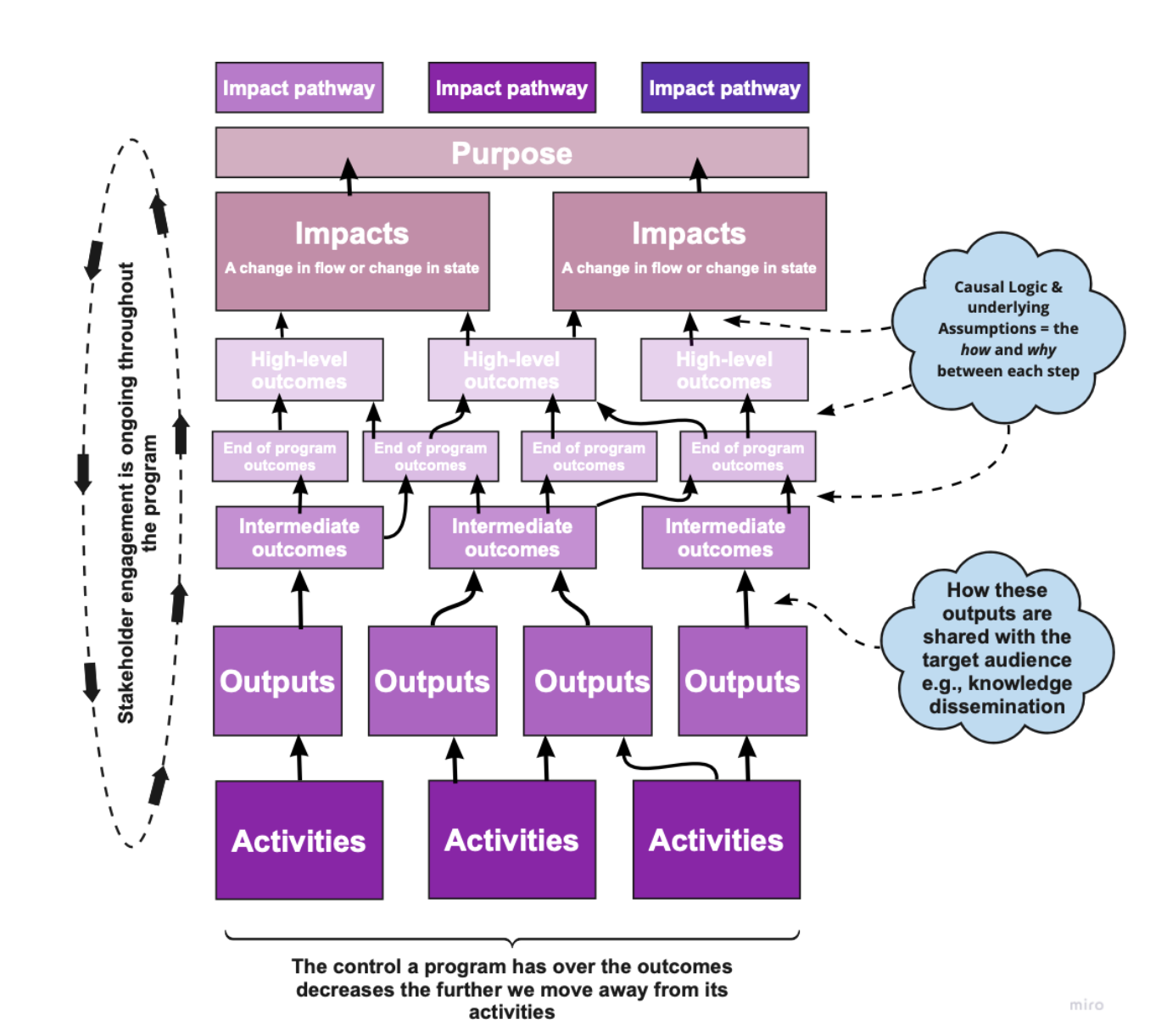Differences Between Theory Of Change, Log Frames, Results Frameworks And Logic Models – What Are They And When To Use Them
July 2022
This article is rated as:
In some of our previous articles, we’ve introduced and explained how to use different evaluation planning tools for identifying and assessing outcomes. You might have noticed how there seem to be quite a few tools doing very similar things. It’s no surprise that these tools can sometimes be confused, and the lines can be blurred around when and how to use them.
To help you on your way to deciding which tool is best suited to your evaluation, we’ve selected a few of our favourites to compare and contrast. These tools include:
Theory of Change (ToC)
Log Frames
Results Frameworks
Logic Models
There are some common points across all of the available tools:
All tools provide transparency and a visual explanation for why your program is expected to contribute to change
All tools can help to track progress towards a specific objective
All tools can be used at both the planning and evaluation stages of a program
All tools are living documents and should be reviewed throughout the program lifespan
All tools are time-consuming to develop, but to differing extents; they all require some reflexivity and strategic thinking to develop
Theory of Change (ToC)
What
Explains how a set of activities will solve a problem through a diagram often made up of boxes and arrows
Goes into more detail by explaining the why also known as the “casual logic;” i.e., why one step is expected to lead to the next
Why
Explanatory and best suited to complex programs that are influenced by multiple systems
By defining long-term goals and then mapping backwards to identify necessary preconditions, ToC can provide the basis for arguing that a program is making a difference whilst identifying weaknesses in the argument and providing the opportunity to make changes
When
Can be used to both design and evaluate programs
Can be developed at any stage of an intervention
ToCs are living documents and should be flexible to the program’s needs and any changes happening on the ground
Strengths
ToCs capture unintended and unexpected results
Provides a reporting framework and identifies what data need to be gathered to test the theory
Weaknesses
Can be challenging and time-consuming as it involves facilitating collaboration with all key interest holders, synthesizing a range of views and information sources, as well as obtaining agreement and buy-in from interest holders
Log Frames
What
Focused on how you will get to your program’s goal
Usually presented as a matrix which structures the main activities in a program, highlights the logical connections between them, and identifies what these activities are expected to achieve
Why
Descriptive and better placed for small to medium-sized projects
Log Frames help you to think about the relationships between available resources, planned activities, and the desired changes or results
When
Most Log Frames are developed during program design and are updated throughout the program’s life span
Like ToCs, Log Frames are not set in stone and should be flexible to the program’s needs
Strengths
It ensures objectives are clear and measurable
It ensures that concrete evidence for a program’s achievement is collected
Because risks and assumptions are made explicit, problems can be analyzed systematically
Weaknesses
It is a one-size-fits-all all approach, which does not always capture the complexity and context of a program
Don’t easily capture the how and why in the same way a ToC does
Results Frameworks
What
Often in the form of a matrix that links activities with outcomes and results that directly relate to the objectives
Captures the essential steps of the logical and expected cause-and-effect relationship within a program
Why
Focus on explaining the program’s results
It helps achieve strategic objectives, i.e., the ultimate driver of the program, by showing where resources could be best leveraged
When
Useful as part of a strategic planning process
It is a living management document to support consensus, guide course correction, and serve as an accountability framework for evaluation
Strengths
Helps identify and focus on specific, high-leverage outcomes
Helps establish an evidence-based approach to monitoring and evaluation
Helps measure progress towards strategic objectives
Weaknesses
The effects of interventions can be difficult to fully measure as unintended consequences and external influences are not captured. This can lead to a risk of tunnel vision
Logic Models
What
Usually presented in a flow chart (not a matrix)
Logic models visually summarise how a program is expected to work by listing: what resources will be used, what activities will be completed, and how the activities will lead to outcomes
Why
Logic models reveal the intention, assumptions, and rationale behind a program
Logic models are useful to support interest holders to think through and understand why a program is expected to lead to change
When
In the planning phase, logic models can help to shape program strategies, set priorities, and illustrate approaches to interest holders
During program implementation, logic models can support accountability
Strengths
Builds a common understanding of goals, processes, and expectations for resources
Can help to explain the need for a program to the community, organization, or funder
Known for their easy-to-use format
Weaknesses
Don’t capture unintended or unexpected results
Don’t capture causality
While some logic models capture contextual factors and assumptions, they are often high-level and don’t look at each specific step within the change process
Theory of Change (ToC)
Main Components:
Activities
Outputs
Outcomes
Impacts
Purpose statement
Impact pathways
Description of the causal logic
Description of the key actors
Description of the indicators
Assumptions (the factors outside of the program’s control that are necessary to ensure the program’s success)
Description of alternative explanations and external factors (i.e., the different ways that may lead to change that are not related to your program) are often included in the narrative.
Log Frames
Main Components:
Main Goal
Outputs
Outcomes
Activities
Log Frames may also include indicators of how you will measure change and risks or assumptions underlying the change
Results Frameworks
Main Components:
Activities
Outcomes (intermediate and longer term)
Impacts (longer term)
Outputs
Indicators
Critical assumptions and risks that must be in place for the intervention to be successful
Results frameworks are often accompanied by a monitoring plan which includes baseline values and targets for expected outcomes and specifies the measures of achievement
Logic Models
Main Components:
Goals
Inputs
Activities
Audience
Outputs
Outcomes
Have you worked with any of these models before, or do you notice one that’s missing from our list? Comment below or connect with us on LinkedIn!
Sources:
Belcher, B., Davel, R., & Claus, R. (2020) “A refined method for theory-based evaluation of the societal impacts of research”. MethodsX. 7(1). Available from: https://www.sciencedirect.com/science/article/pii/S221501612030008X
Hearn, S. (2009) “Outcome Mapping: Monitoring and Evaluating Policy Influencing” Presentation for Overseas Development Institute. Available from: https://www.slideshare.net/sihearn/om-for-policy-influencing
Mitroff, I., & Bonoma, T. V. (1978). Psychological assumptions, experimentation, and real-world problems: A critique and an alternate approach to evaluation. Evaluation Quarterly, 2(2), 235–260. Available from: https://doi.org/10.1177/0193841X7800200204
Nkwake, A.M. (2012) Working with Assumptions in International Development Program Evaluation: With a Foreword by Michael Bamberger. Springer Science & Business Media: Berlin, Germany.
Stein, D., & Valters, C. (2012) “Understanding Theory of Change in International Development”. Justice and Security Research Programme at the London School of Economics and Political Science. Available from: http://eprints.lse.ac.uk/56359/1/JSRP_Paper1_Understanding_theory_of_change_in_international_development_Stein_Valters_2012.pdf
Jones, N. D., Azzam, T., Wanzer, D. L., Skousen, D., Knight, C., & Sabarre, N. (2019). Enhancing the Effectiveness of Logic Models. American Journal of Evaluation, 1098214018824417. https://doi.org/10.1177/1098214018824417








